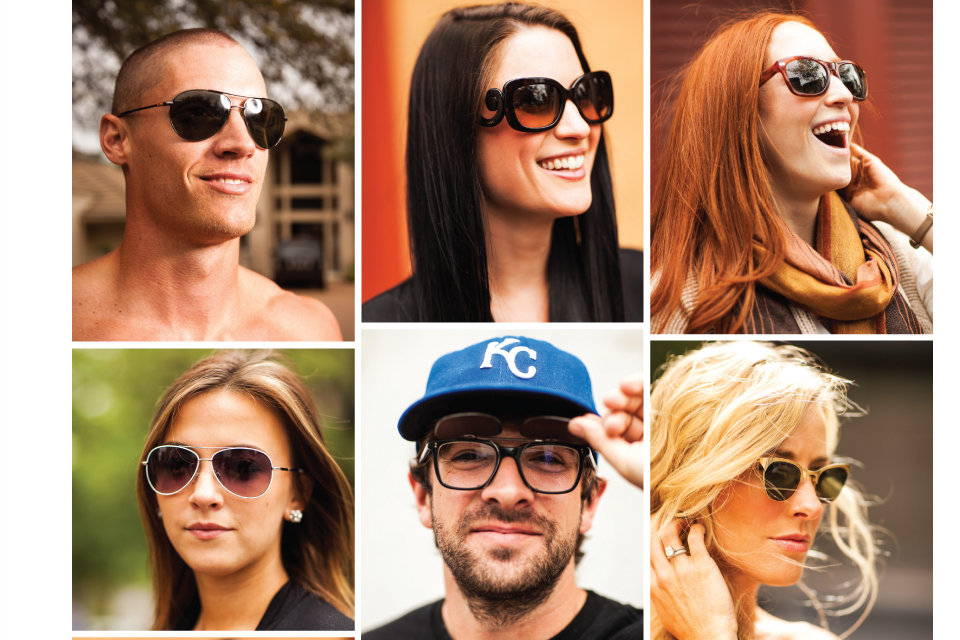The Many Shades of Style

Sunglasses come in all shapes and sizes, but combining the right amount of style and protection is key to keeping you safe and stylish. Whether you're going for a classic Wayfarer look or want to give back to the community, these shades will keep you covered.
Wayfarer The James Dean of sunglasses. This classic style by Ray-Ban was introduced in 1953 and continues to be the most sought-out and replicated style of sunglasses to this day.
Oversized Probably the most common type of sunglasses you see on a day-to-day basis. Although these are used more as a fashion statement, oversized sunglasses offer more protection from sunburn because of the larger area of skin they cover.
Do-Good Sunglasses Warby Parker and Toms work with experienced nonprofit partners to provide “one-for-one” programs through which a person in need receives a pair of sunglasses every time a pair of sunglasses is purchased.
Clip-on/Flip-up Sunglasses Clip-on and flip-up lenses offer great benefits to people who wear corrective lenses. These are a form of tinted glasses that can be attached to eyeglasses; this allows protection from the sun when outdoors and the benefit of keeping track of one pair of glasses when indoors.
Swim Goggles Eye protection is not just limited to the sun; it’s essential for anyone spending time in the water. Pools with chlorine, a salty ocean, and a lake full of debris all contain hazards to the eyes. Some swim goggles can also protect the eyes from UV rays as well.
Sure, sunglasses look good and protect the eyes but did you know they are crucial to maintaining good eye health? Here are the three reasons sunglasses should be a top priority for a healthier lifestyle:
1. UV Protection
Cataracts and photokeratitis, a temporary but painful sunburn of the eye's surface, are two of the biggest concerns when exposed to the sun's UV rays. Wearing caps or wide-brimmed hats can block out around 50 percent of the sun's UV rays but that is not enough protection.
2. Dark Adaptation
Spending just a couple of hours in the sunlight can hinder your eye's ability to adapt to nighttime or indoor light levels. This can especially be hazardous when driving at night.
3. Skin Cancer
This is one of my biggest concerns and one of the main reasons I wear sunglasses on a daily basis, rain or shine. Cancer of the eyelids and of the skin around the eyes is more prevalent that most people think. People should always wear sunglasses—whether they are working outdoors, driving, playing sports, taking the dogs for a walk, or just running errands.
What type of lenses should you choose?
My personal favorites are polarized lenses; they are the most effective at blocking glare. These lenses are suited for bright and sunny conditions where your sight can be harmed by glare from objects and surfaces such as water and glass. Look for sunglasses that block out 99 percent of UV-A and UV-B rays and 75 to 90 percent of visible light. To ensure you are getting the most benefit, consult with your optometrist on what best fits your eye-care needs. This doesn't mean you have to purchase the most expensive pair of glasses to block out UV rays; there are plenty of reasonably priced options. Higher cost normally depends on the type and quality of frames and the optics of the lenses themselves.
Tips for Healthier Eyes
1. Wear some sort of protective eyewear any time your eyes will be exposed to UV rays, whether it be cloudy or cold.
2. Look for quality sunglasses that will offer good protection. Note that “quality” doesn’t necessarily equal “expensive.”
3. Always make sure children and teenagers are covered, since they are typically in the sun more than adults.
4. Don't want to alter the color of certain objects? Go with grey-colored lenses; they reduce light intensity while providing the most naturally colored vision.
5. Don't forget your sunblock!






